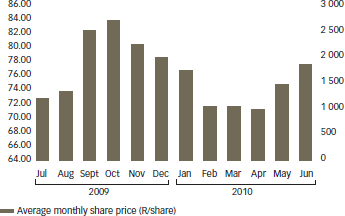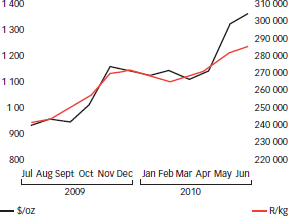![Harmony [logo]](i/logo.png)
![Harmony [logo]](i/print_logo.png)

Patrice Motsepe,
Chairman
- Home <
- Business review <
- Chairman's letter
Chairman's letter
Dear shareholder
A year ago I had the pleasure of congratulating Harmony’s committed team of managers and employees on their efforts in aiding the company to weather the economic storm of 2008. This year, I extend my thanks to a team that has continued to build and position Harmony for a safe, sustainable and profitable long-term future.
As we continue to strive to deliver on our key objectives of profitability, growth and safety, the experience and skills of our management team, enables us to competitively manage and operate our current and new mines. This combination of a world class management team, coupled with a good range of mining assets, provides a compelling endorsement of Harmony’s investment merits.
Looking ahead, we anticipate cost challenges, notably the prospect of administered electricity costs that, in round figures, are set to rise by 25% in each of the next two years. However, this is manageable if our productivity advances and our target to remain South Africa’s lowest-cost producer measured in terms of rands per underground tonnes mined is achieved.
Strategy
Harmony’s focussed strategy is based on two main pillars: the competitive production of profitable ounces of gold and safety. This strategy has as its overall goal the production of 2 million, safe and profitable ounces annually by FY2013. In striving for this, the intention is to transform Harmony into a sustainable company that has free cash flow and that is able to generate earnings to fund both growth and dividends.
Growing the company and generating free cash flow will entail:
- optimising our asset portfolio so as to yield lower-cost, more profitable, high-margin ounces. To this end our portfolio was reviewed and restructured;
- increasing levels of operational efficiency and productivity, to which end capital projects are being commissioned and achievable plans have been compiled for the development of face length so as to optimise mining flexibility; and
- exploring and expanding into new geographic regions, developing mines, acquiring low-cost assets and entering into joint ventures.
Together, these actions will help us achieve the targeted growth in ounces and generate free cash flow.
Safety
It is with deep regret that I extend my condolences to the families and colleagues of the 22 miners who lost their lives at work during the year. Every fatality at our mines is one fatality too many.
We remain determined in our efforts to continuously improve safety standards and records, and our target of zero fatalities remains steadfast. We make every effort to ensure that stringent safety procedures are implemented at all operations and that adherence to these procedures is so ingrained as to become second nature to every one of our employees.
I would like to extend my gratitude to those who have contributed to improving Harmony’s safety efforts.
Mining
Harmony has significant growth potential in Papua New Guinea and together with our South African operations will continue to underpin planned growth as the key focus of our business.
Harmony has planned for increased production over the next five years and our fundamental aim is to generate profit for our shareholders, whilst continuing to grow. Equally, we are committed to profitable opportunities that can provide secure job opportunities and fair remuneration for our employees and that enable us to contribute to the betterment of the communities and the countries where we operate.
We met our sustainable operating margin objective of 26% in this past financial year. Maintaining this margin will almost inevitably lead to the closure of old and unprofitable shafts, as happened in the year under review. We cannot allow loss-making operations to threaten our overall economic security. Our immediate plans in this regard are described in more detail in the CEO’s annual review.
We will continue to pursue appropriate opportunities for acquisitions or take overs. Fundamentally, though, Harmony’s future will be tied principally to its own exploration successes, as indicated by our projects in Papua New Guinea. In that country, the Hidden Valley mine has reached commercial production, one of our exciting achievements of the year.
The gold market
Our confidence in gold has been and continues to be justified. The metal’s price performance over the past year – reaching an all-time record of $1 261/oz towards the end of our financial year, comes at the end of a decade of sustained increases and at a time when the prospects for some of the major economies in the world remain uncertain.
Harmony is not alone in its view on stronger gold prices. Normally cautious leading gold analysts such as GFMS and the World Gold Council forecast prices reaching heights of $1 300/oz by December 2010. These levels were in fact breached by the end of September. These predictions are based on market fundamentals of supply and demand rather than on short-term speculation. Our view is that the world’s financial markets have not yet stabilised, indicating a steady gold price progression in the medium and long term.
On the demand side, the Asian giants, China and India, continue to build their official gold reserve holdings, while individuals across the globe increase their holdings either directly through their holdings of bullion or indirectly through exchange traded funds. By way of example on the production side, China, which has emerged as the single largest national producer of newly-mined gold, still has to import gold to meet both domestic private and official demand. In South Africa, though, overall production from the country’s mature mines continues to decline.
While this positive outlook remains in place, Harmony’s forward planning is conservative, which affords protection against adverse currency shifts as the company’s operating costs are largely denominated in South African rands.
In the year under review, the rand continued to strengthen against the dollar, which squeezed our operating margins. The rand’s exchange rate against the dollar averaged R7.58/$ as compared with R9.00/$ during the 2009 financial year. The result was that though the year’s average gold price rose by 26% to $1 092/oz from $867/oz the previous year, in rand terms the average price received rose by only 6% to R266 009/kg from R250 826/kg.
Based solely on existing operations in South Africa and Papua New Guinea, our planning envisages a steady and substantial increase in gold production to an annual 2 million ounces over the next three years, while maintaining unit costs to less than R200 000/kg in real terms. In addition, our Wafi-Golpu project in Papua New Guinea is at the conceptual study stage. At present its equivalent gold mineral resource stands at 39 million ounces, with significant scope for additions – indeed a very exciting prospect for the company! Our target is to bring its gold-copper operations into commercial production by 2016.
Average monthly share price

Average monthly gold price

Harmony, a sound investment case
Given the above, I firmly believe that Harmony represents a solid emerging-markets investment case. Its main attributes are:
- a sustained focus on profitable operations;
- steady production growth prospects with rising average grades;
- unhedged against the gold price and exchange rates;
- balance sheet in a net debt position with financial resources and cash flow to target future acquisitions;
- a large resource base on which to build production growth;
- a world class management team skilled in developing and operating mines at all stages of their mine lives; and
- a focussed commitment to delivering progressive returns to shareholders through dividends and share price growth.
Thanks
My unqualified thanks go to the board, the chief executive officer, Graham Briggs, for his outstanding leadership and to the first-rate team of managers and employees for their unstinting efforts and commitment towards growing Harmony into a leading world-class gold producer. I am confident that their contributions will ensure Harmony’s sound future.
Lastly, I want to thank Frank Abbott, who, post year-end, has retired as an executive director, for his contribution to the growth of Harmony over many years. Frank will remain on our board as a non-executive director. I would also like to welcome Harry Ephraim “Mashego” Mashego, the new executive director at Harmony.
Patrice Motsepe
Chairman
25 October 2010
HARMONY ANNUAL REPORT 2010